We interviewed Cristina Casadei from the Carlo Zauli museum to fully understand the collective work behind the great ceramic sculpture: the Kabira horse designed by the artist Chiara Camoni and built through a participatory action.
How did the idea of the big black ceramic horse Kabira come about and how did the collective and participatory action take place?
Kabira stems from Chiara Camoni’s idea of confronting the issue of difficulty, which she identified and summarized in the figure of the horse, with which she had a personal relationship that was both intense and complex.
“Kabira was a white horse.
But it was also my relationship with the unconscious that surfaced.
Kabira was down in the field and up in my dreams.
It was my incapacity.
My determination.
Frustration.
It was a dragon.
It was fear and enchantment.
It was the reversal of beliefs. “
The idea also starts from the invitation to compete with the size of the workshop, a moment of sharing of theoretical and manual knowledge, which Chiara has put into practice in 3 days in which to produce, read and discuss together:
“During the workshop practical moments and theoretical moments will alternate. We will be accompanied by some texts that will constitute the coordinates within which the action of the hands will develop. After the reciprocal presentations, we will address the topic of taboo in art. We will talk about the subject in sculpture, collective practices and shared knowledge. Full and empty, dark areas. We will read excerpts from The Ignorant Master by Jacques Ranciére, The Sculpture Dead Language by Arturo Martini, Reincanting the World by Silvia Federici and other books again. We will work with the black clay from Belgium made available by the Zauli Museum, preserved in the underground rooms. Individual work will flow into a collective project. We will perhaps make a great black horse.”
The work is therefore born from a personal project, the result of an intense memory shared since the first moments of the workshop with the participants: the testimonies and the resulting comparison immediately made it a multi-headed project, and of course with several hands.
Ceramists, artists, female students, passing friends, the staff, we have all interpreted Chiara’s technical indications, in a series of simple and repetitive actions to be performed by listening to the readings. Kneading the earth, shaping it in small, free and repeated forms, piercing the shapes, putting the dried forms into long necklaces, dressing the wooden structure with these necklaces … we found ourselves on several occasions in real collective rituals. It was an experience that exceeded all expectations of production, training and sharing.
The artist Chiara Camoni described the “Kabira operation” as follows: “We will build the wooden supporting structure and insert all the small pieces that will form the covering of the body into long necklaces. Born from the dark clay of the underground, I now imagine the presence of this horse in the oven room, which looks towards the entrance. I would like this sculpture to be a place that could be entered below, a kind of hut.” How did the relationship between the museum and the artist come about?
Matteo Zauli had already worked with Chiara Camoni two years ago on a cycle of residences in Montelupo Fiorentino. On that occasion she had created multi-hand vases, involving students and artisans, at the same time competing with the production dynamics of the large workshop, with which she made interesting experiments on enamels.Her research, always focused on relational contexts and group dynamics, fascinated us particularly, identifying it as an ideal figure for the training project that we have been carrying out for two years with AiCC, the Italian Association of Ceramics Cities, for ceramists. After Francesco Simeti, she was the second artist invited as a lecturer in one of our workshops, all permeated by a vision of ceramics that keeps thinking together, overcoming the divisions between art, craftsmanship and design.
What relationship does the museum have with the city of Faenza, how do citizens welcome participatory activities like this?
The museum was born from the laboratory of Carlo Zauli, an artist who brought ceramics, and his city, into international settings. He has traveled all over the world with his works while remaining closely connected to the land of origin, in which he has always lived and worked. With this same dualism the museum stands out as a small provincial institution, with the main mission of bringing the stimuli of international contemporary art to the city. And the people of Faenza perceive the museum as a unique place in the territory where unique, unmissable things happen. Like this.
What role does the communication of the museum play in a project like this? And how much does communication of art and your activities during normal annual planning count for you in general?
Communication was fundamental for the participation of the workshop participants, who were 16, the maximum expected, coming from all over Italy, using our different channels. Then we sought the support of the local press to involve the city in the final assembly, which in fact became almost a happening, as we had imagined it. For those who could not participate, we told all the steps through social networks, in particular with Instagram stories.
For us too communication is fundamental, as well as a great work commitment. At this moment we are looking for a compromise between the need to inform about all the museum events and the need not to overload with news those who follow us!
Finding ourselves decentralized with respect to the trajectories of the contemporary Italian, the thing that fascinates us most is the feedback from the public that follows us from afar, even without ever having been here: contemporary communication plays a powerful role on the diffusion (even) of art. And with satisfaction, and also a bit of wonder, we must say that the most appreciated contents are always those dedicated to Carlo Zauli!
Can you anticipate some future project?
An autumn full of events awaits us: the second workshop with the most pop ceramist in Italy, or Giorgio di Palma, who invites the participants to make ceramics that were not needed. We will have new young artists in residence from Tel Aviv, our festival of contemporary music, Ossessioni, this year focused on Morton Feldman, a conference on Guido Gambone and the final exhibition of the 2019 residences. On October 17, in fact, inaugurates the exhibition presenting the results of the work of the guest artists of this summer: Giulia Bonora, Arianna Carossa, as well as of course Chiara. Giulia Bonora has created sculptures with the ancient technique of wicking, which she constantly used in a contemporary key, in a project related to containers and water collection. For her, the residence was also a moment of in-depth study of the infinite shades of blue, her precise chromatic code, in ceramic glazes. Arianna Carossa also in Faenza worked on her poetic journey with which she links nature and culture, combining organic remains of animals in new sculptural assemblages. Honeycombs, horns and shells have therefore entered the sculptures modeled with the black earth of Belgium that Carlo Zauli himself used for his monumental stems.
Info:
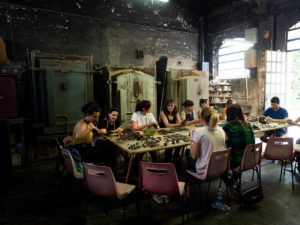
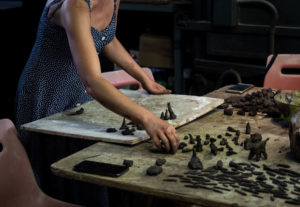
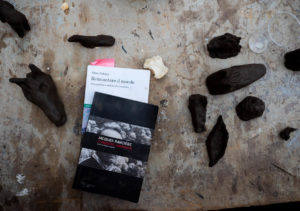
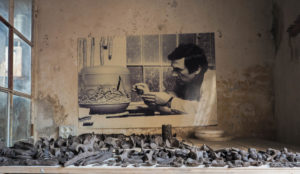
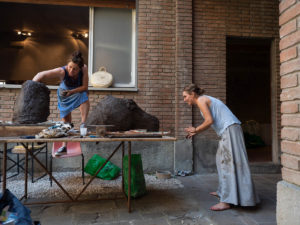

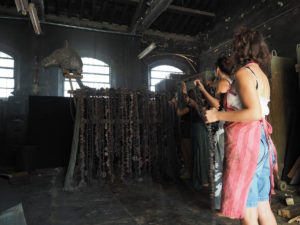
For all the images: Chiara Camoni, Cavallo Kabira, workshop, Museo Carlo Zauli, Faenza, 2019 – Ph. Angela Grigolato Courtesy Museo Carlo Zauli
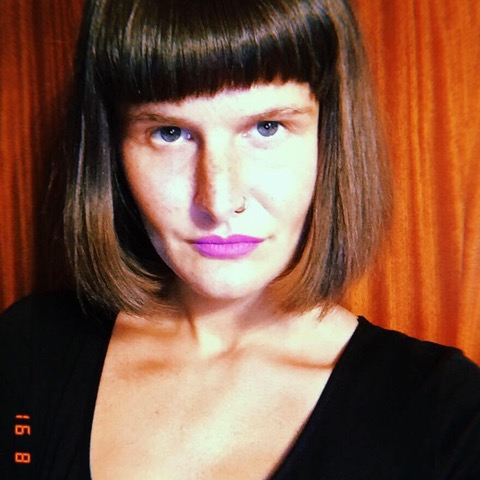
(1990) Graduated at DAMS in Bologna in Visual Arts with a thesis on the relationship and the paradoxes that exist between photography and fashion, from Cecil Beaton to Cindy Sherman, she specializes at the Academy of Fine Arts in Bologna in the two-year course in art teaching, communication and cultural mediation of the artistic heritage with a thesis on the historical-critical path of Francesca Alinovi, a postmodern critique. Since 2012 she has started to collaborate with exhibition spaces carrying out various activities: from setting up exhibitions to writing critical texts or press releases, to educational workshops for children, and social media manager. She has been collaborating since 2011 with various magazines: Vogue online, The Artship, Broken Fracture, Wall Street International Magazine, Forme Uniche Magazine.






NO COMMENT